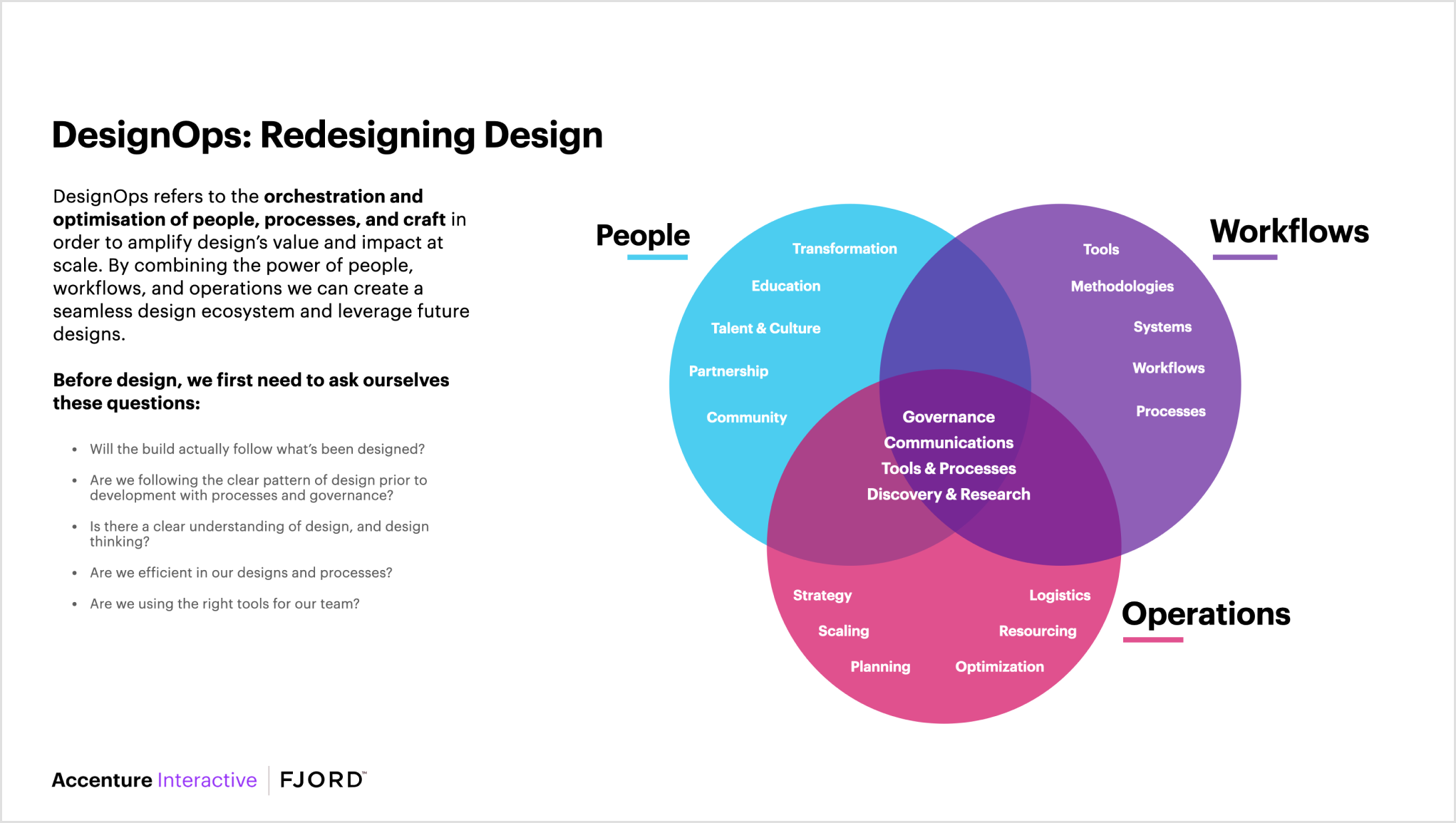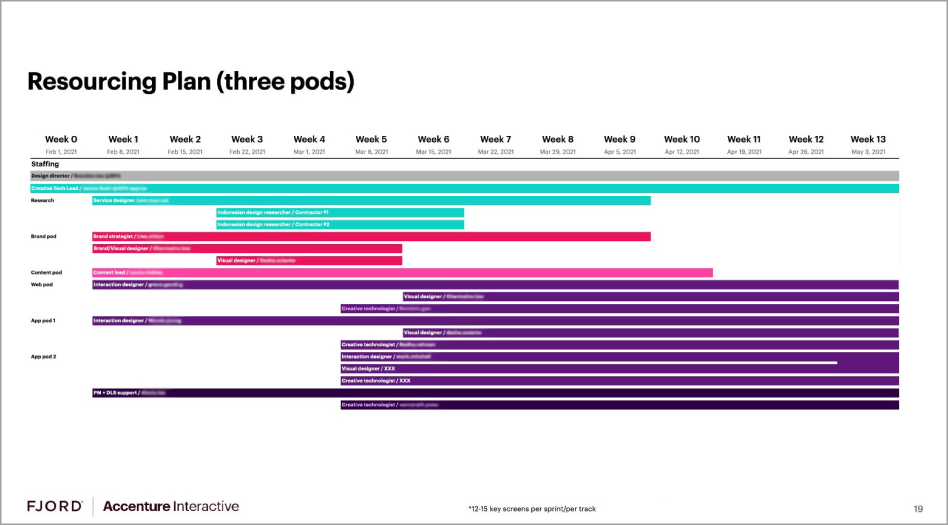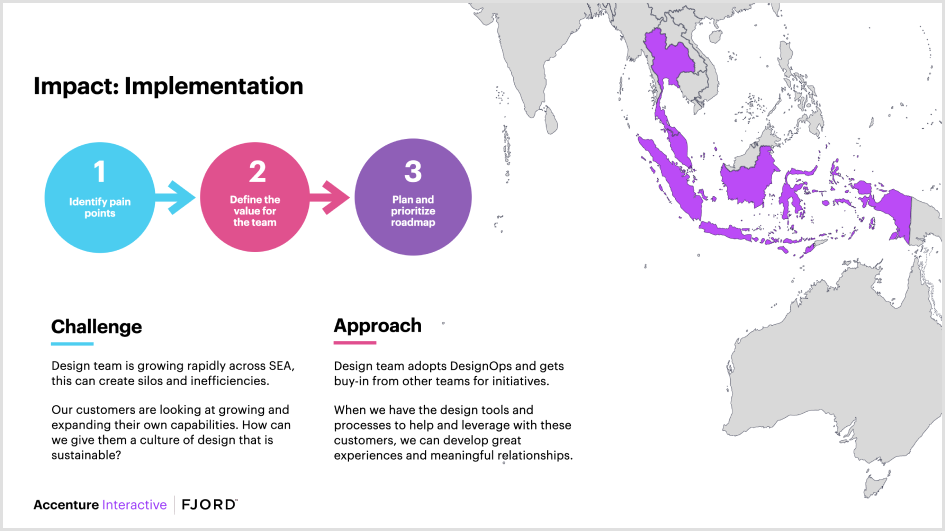In today’s world, digital transformation is about creating captivating experiences digitally using marketing, technology and design. Within Accenture Interactive’s multi-talented team, sits the heart of the Design Pillar. This full-service design team encompasses: Interaction Design, Visual Design, Service Design, Creative Tech, Research and Copywriting.
DesignOps refers to the orchestration and optimization of people, processes, and craft in order to amplify design’s value and impact at scale. As companies invest in design and technology capabilities, there needs to be a clear prioritisation, hiring, and processes within teams to allow designers to focus on their craft. Allowing designers to design the best possible experiences for our customers.
DesignOps for Accenture
Role & Duration
DesignOps Manager
UX Management, Project Management
2019 - 2021
Core Activities
Workshop facilitations, People Management, Design Facilitation & Planning, Sprint Planning, Presentations & Bid Management.

Sector
—
Design Consultancy
Team size
—
100+ Designers across SEA
Countries
—
7 (APAC region)
The goal
Ensure that things such as planning, onboarding newcomers, knowledge sessions, and having seamless workflows so that the designers can focus on designing. This helps us create better plans for clients and help our designers focus on what they do best: designing world-class, digital experiences.
This tactical approach of integrating DesignOps is to support the leads and the designers under them to ensure a clear execution of the vision and strategy in the most effective and seamless way.

The approach
Clearly define and implement repeatable process to fit every type of project — including overall planning and guidance principles. Then planning with teams and other managers on best resource allocation-fit based on budget, timeline and desired level of designers that best fit within that project type.
Overall, the importance of DesignOps is often over-looked. Having governance for a design team that enables designers to grow and thrive is key to a successful team and successful projects out outcomes. Working on these initiatives internally and with clients taught me that DeisgnOps is not “one size fits all”. There are many different types of teams and the level of acceptance for design varies across companies and industries.

Challenges
Overall, the importance of DesignOps is often over-looked. Having governance for a design team that enables designers to grow and thrive is key to a successful team and successful projects out outcomes.
DeisgnOps is not “one size fits all”. There are many different types of teams and the level of acceptance for design varies across companies and industries.
Opportunities
Strengthen operational levels within design teams to better manage people in multiple different projects, and to better integrate a culture of design within the digital transformation process.
Create and define standardisation for internal planning, operational methodologies, and guidelines to facilitate adoption across multiple teams to reduce inefficiencies and improve team communication across ASEAN and globally.
Core outcomes
Onboarding new team members with purpose
The absence of structured onboarding was affecting not only new designers but also experienced designers and managers. This raised the question to start with the basics: Is there a better way to manage this while preserving design team values?
The new onboarding framework was quickly adopted by other teams and scaled across 500+ people within the ASEAN region. Over time, the DesignOps approach evolved within the ASEAN team and was later expanded across the APAC region.
Defining scalable processes and roadmaps
Improved processes and roadmaps for a large design team in a consulting firm—shaping how teams come together for projects of any size, building stronger pitches, and guiding work from planning through delivery.
Brought in best practices that made projects more visible and helped the team respond faster when challenges popped up, strengthening how we delivered work across the board.

Key takeaways
Onboarding ecosystem with the use of presentations, important documents, “buddies”, and core self-learnings.
Processes and roadmaps for projects that include how to build better teams for various sized project, pitch building, roadmaps and execution, project best practices to build better visibility and reactivity to any issues that might occur.
Design standardisation with the use of tools and templates that we provided for the designers. By creating a repository of “best in class” examples and templates, we could help guide all types of designers. This wasn’t just limited too tools, it also included trainings and interesting topics that were found and shared.
People management that focuses on the overall health of the team, resource allocation based on designer development and career progressions, skills matrix, team engagement, and budgeting for projects, etc.
Implementing design strategy and scaling best-project-practices by creating a repository and repeatable processes to create clear tracking metrics, status updates, leadership updates, design playbooks, best design practices, CVs, case studies, etc.




